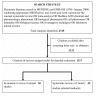Methodological quality of systematic reviews of animal studies: a survey of reviews of basic research
- PMID: 16533396
- PMCID: PMC1435907
- DOI: 10.1186/1471-2288-6-10
Methodological quality of systematic reviews of animal studies: a survey of reviews of basic research
Abstract
Background: Systematic reviews can serve as a tool in translation of basic life sciences research from laboratory to human research and healthcare. The extent to which reviews of animal research are systematic and unbiased is not known.
Methods: We searched, without language restrictions, Medline, Embase, bibliographies of known reviews (1996-2004) and contacted experts to identify citations of reviews of basic science literature which, as a minimum, performed search of a publicly available resource. From these we identified reviews of animal studies where laboratory variables were measured or where treatments were administered to live animals to examine their effects, and compared them with reviews of bench studies in which human or animal tissues, cell systems or organ preparations were examined in laboratories to better understand mechanisms of diseases.
Results: Systematic reviews of animal studies often lacked methodological features such as specification of a testable hypothesis (9/30, 30%); literature search without language restriction (8/30, 26.6%); assessment of publication bias (5/30, 16.6%), study validity (15/30, 50%) and heterogeneity (10/30, 33.3%); and meta-analysis for quantitative synthesis (12/30, 40%). Compared to reviews of bench studies, they were less prone to bias as they specified the question (96.6% vs. 80%, p = 0.04), searched multiple databases (60% vs. 26.6%, p = 0.01), assessed study quality (50% vs. 20%, p = 0.01), and explored heterogeneity (33.3% vs. 2.2%, p = 0.001) more often.
Conclusion: There seems to be a gradient of frequency of methodological weaknesses among reviews: Attempted systematic reviews of whole animal research tend to be better than those of bench studies, though compared to systematic reviews of human clinical trials they are apparently poorer. There is a need for rigour when reviewing animal research.
Figures
References
-
- Weed DL, Hursting SD. Biologic plausibility in causal inference: current method and practice. Am J Epidemiol. 1998;147:415–425. - PubMed
Publication types
MeSH terms
LinkOut - more resources
Full Text Sources



